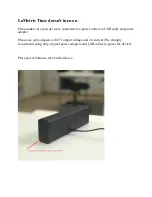
RX
−
8564
LC
Page
−
18
ETM12E-01
13.2. Fixed-cycle Timer Interrupt Function
The fixed-cycle timer interrupt function generates an interrupt event periodically at any fixed cycle set between
244.14
µ
s
and 255 minutes.
There are two operation modes: "level interrupt mode" whereby the operation ends after one time, and "repeated
interrupt mode" whereby the operation is automatically repeated.
When either of these interrupt events occurs, the event's occurrence is indicated by the "1" value set to the TF
bit and by the low-level ("L") status of the /INT pin.
13.2.1. Overview of fixed-cycle timer interrupt function
•
The fixed-cycle timer interrupt function is used with several combinations of settings.
(1)
Operation mode setting (level interrupt mode or repeated interrupt mode)
(2)
Fixed-cycle timer operation period setting (period
=
countdown reference cycle
×
count value)
(3)
Setting as to whether to output (at low level) an interrupt signal from the /INT output pin after a specified
amount of operation time has elapsed.
•
When operation of the fixed-cycle timer starts (TE,
"0"
→
"1"), various events occur after the specified time has
elapsed.
(1)
The TF (Timer Flag)
bit value, which indicates when a fixed-cycle timer interrupt event has occurred, changes
from "0" to "1".
(2)
When the TIE
(Timer Interrupt Enable)
bit value is "1", the /INT output pin status changes from Hi-Z to "L".
1) Overview of level interrupt mode
(TI/TP bit =
"0")
Once an interrupt event has occurred, the operation ends after one iteration.
∗
However, if only the TF bit is cleared to zero without stopping operation of the fixed-cycle timer
(TE bit
value remains "1"), note with caution that an interrupt event will occur during the next timer cycle (period).
If an interrupt event occurs during level interrupt mode, the /INT output goes to low level.
The low level output is maintained as it is until the TF bit is cleared to zero.
(When TIE
=
"1"
)
∗
Example of /INT
operation
TIE =
"
1
"
TF
=
"
0
"
TF
=
"
0
"
→
"
1
"
TE
=
"
0
"
→
"
1
"
TF = " 1 "
→
"
0
"
period
2) Overview of repeated interrupt mode
(TI/TP bit =
"1")
After an interrupt event occurs, the operation is automatically repeated.
When an interrupt event occurs during repeated interrupt mode, /INT output goes to low level only during
the tRTN period, and then it is automatically canceled and returns to Hi-Z status.
However, even after returning to Hi-Z status, similar /INT output is obtained after the next interrupt event
occurs.
Afterward, this is repeated until fixed-cycle timer operation is stopped.
∗
Example of /INT
operation
Auto reset time
tRTN
TIE = " 1 "
→
"
0
"
period
TIE =
"
1
"
TF
=
"
0
"
TF
=
"
0
"
→
"
1
"
TE
=
"
0
"
→
"
1
"
















































